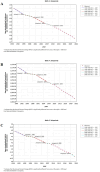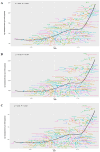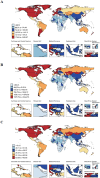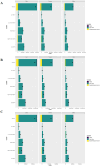Global, regional, and national burden of older adult atopic dermatitis in 204 countries and territories worldwide
- PMID: 40241972
- PMCID: PMC11999981
- DOI: 10.3389/fpubh.2025.1569119
Global, regional, and national burden of older adult atopic dermatitis in 204 countries and territories worldwide
Abstract
Background: With the aging global population, older adult atopic dermatitis (AD) is emerging as an increasingly significant health challenge. This study aimed to evaluate the global burden of older adult AD from 1990 to 2021 and to project its change to 2050.
Methods: The estimates and 95% uncertainty intervals of prevalence, incidence, and disability-adjusted life-years (DALYs) attributable to AD among individuals aged over 60 years were extracted from the Global Burden of Diseases (GBD) Study 2021. We used joinpoint regression analysis, decomposition analysis, cross-country inequality analysis, frontier analysis and prediction model to epidemiological analysis.
Results: From 1990 to 2021, the global prevalence of older adult AD increased to 11,009,630 cases (95% UI: 9,915,829 to 12,170,941), even as ASRs declined, which were primarily driven by population growth. It was observed that females and 75-79 years old had higher incidence rates. SDI relative and frontier analysis exhibited that incidence, prevalence and DALYs rates were positively correlated with SDI levels, while SDI-related inequalities had a significant decrease. Predictions up to 2050 anticipated increasing older adult AD incidence, prevalence, and DALYs numbers, while only age-standardized disability-adjusted life-year rates (ASDRs) were expected to decline.
Conclusion: The burden of older adult AD varied by genders, age groups, regions, countries and climatic conditions. Although the ASRs had shown a decline over time, the burden of older adult AD remained significant, especially in regions with high SDI levels. In the future, the burden of older adult AD was projected to continue rising until 2050, thereby targeted interventions and public health strategies were needed to address this trend.
Keywords: atopic dermatitis; disability-adjusted life years; global burden of disease study; incidence; the older adult.
Copyright © 2025 Ou, Shao, Zhang and Chen.
Conflict of interest statement
The authors declare that the research was conducted in the absence of any commercial or financial relationships that could be construed as a potential conflict of interest.
Figures




Similar articles
-
Global, regional, and national burden of asthma and atopic dermatitis, 1990-2021, and projections to 2050: a systematic analysis of the Global Burden of Disease Study 2021.Lancet Respir Med. 2025 May;13(5):425-446. doi: 10.1016/S2213-2600(25)00003-7. Epub 2025 Mar 24. Lancet Respir Med. 2025. PMID: 40147466
-
Global, regional, and national burden of allergic disorders and their risk factors in 204 countries and territories, from 1990 to 2019: A systematic analysis for the Global Burden of Disease Study 2019.Allergy. 2023 Aug;78(8):2232-2254. doi: 10.1111/all.15807. Epub 2023 Jul 11. Allergy. 2023. PMID: 37431853 Free PMC article.
-
Global, regional, and national burden of inflammatory bowel disease and its associated anemia, 1990 to 2019 and predictions to 2050: An analysis of the global burden of disease study 2019.Autoimmun Rev. 2024 Mar;23(3):103498. doi: 10.1016/j.autrev.2023.103498. Epub 2023 Dec 3. Autoimmun Rev. 2024. PMID: 38052263
-
Global mortality, prevalence and disability-adjusted life years of Alzheimer's disease and other dementias in adults aged 60 years or older, and the impact of the COVID-19 pandemic: a comprehensive analysis for the global burden of disease 2021.BMC Psychiatry. 2025 May 19;25(1):503. doi: 10.1186/s12888-025-06661-2. BMC Psychiatry. 2025. PMID: 40389943 Free PMC article.
-
Trends and cross-country inequalities in the global burden of osteoarthritis, 1990-2019: A population-based study.Ageing Res Rev. 2024 Aug;99:102382. doi: 10.1016/j.arr.2024.102382. Epub 2024 Jun 23. Ageing Res Rev. 2024. PMID: 38917934 Review.
References
MeSH terms
LinkOut - more resources
Full Text Sources
Medical

